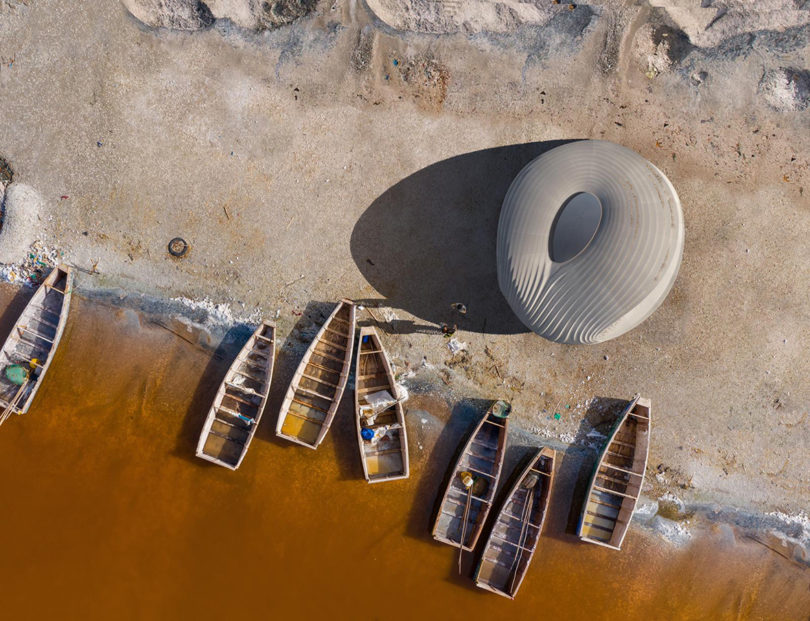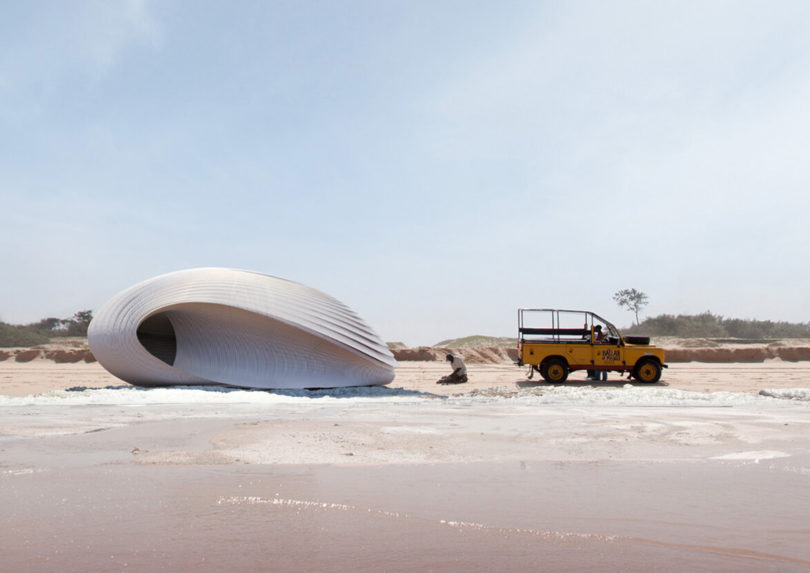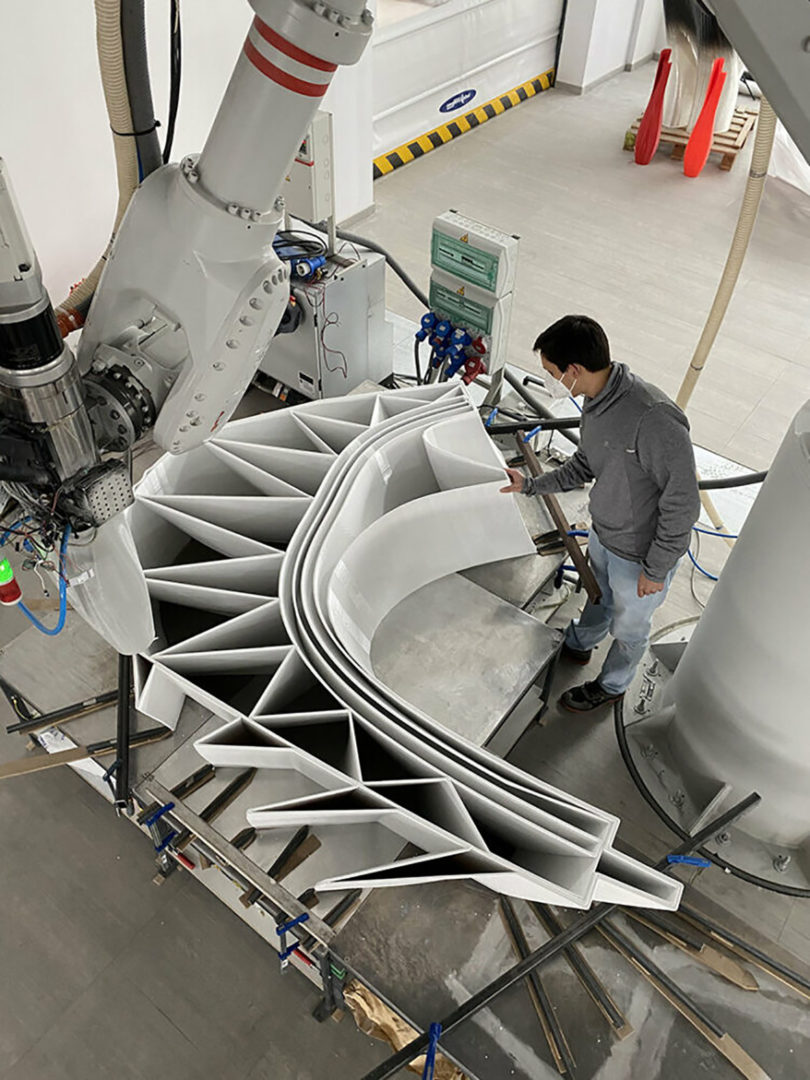The effects of climate change paired with the mounting accumulation of global plastic waste will undoubtedly change the landscape and scope of architecture in the decades ahead. Structures, including housing, will need to be adaptive not only in their intended form, but also in the manufacturing and material sourcing process. Noting these challenges, a 3D-printed prototype pavilion designed by architecture studio Hassell, in partnership with 3D-printing studio Nagami and creative collective to.org, propose utilizing a material that isn’t dwindling, but mounting in availability with every passing day.
Inspired by Qarmaq, a type of inter-seasonal, single-room family dwelling long used by the Central Inuit of Northern Canada, this concept interprets the indigenous architecture into a 3D-printed pavilion constructed with recycled plastic. Engineered for inclement weather and harsh local climates around the globe – in heat or in extreme cold – the small habitat combines traditional indigenous solutions with technological adaptations to permit modifications as required in response to the structure’s site.

In its most extreme iteration the pavilion will be hermetically sealed with its gently grooved exterior designed to collect snow to create natural insulation similar to the traditional igloo.

From overhead, the pavilion’s ridged design with a center skylight resembles a Danish vanilla ring butter cookie, but something more like a marine bivalve mollusk from ground level.
The shell-like design utilizes plastic refuse as a resource for construction, an idea born from conversations between Hassell’s head of design, Xavier De Kestelier, and Manuel Jimenez Garcia, the founder of Nagami, a 3D-additive manufacturing studio.

In warmer climates where insulation from overbearing heat is a concern, the Pavilion 1 can be adapted to use its overlapping fin design for passive cooling and cross ventilation, as well as water harvesting.
“The implications of 3D printing at this scale are huge for architecture and we hope we can apply this aspect of adaptability across projects,” notes De Kestelier, “We wanted a pavilion that will be able to exist completely off the grid and adapt to local climatic challenges and conditions to create as low as possible embodied and operational carbon footprint.”
Additionally, Nachson Mimran, co-founder & creative executive officer of to.org notes the project’s aim to reuse already processed petroleum-based material as “an inexhaustible resource” is vital in the realization of a “circular economy [to] reduce pollution and reverse the effects of climate change.”

Pavilion 1 is 3D printed at full-scale, using minimum energy with the main structure comprising 24 separate pieces easily transported and assembled on-site.
The Pavilion 1 in its varied imagined applications is currently only in a proof of concept state, with to.org currently seeking partners to invest in its future production and work toward reproducible scalability.
Manuel Jimenez Garcia, founder of Nagami hopes the project note only radicalizes the construction industry, but also inspires future generations of architects to invest and explore eco-innovation as a plausible element of designing the habitats of the future.
“Currently, we design 3D ergonomic iPhone cases and custom toilet seats” may read like some random word salad spit out by the AI-operated ChatGPT, yet it is the genuinely strange descriptor greeting visitors at Bailey Hikawa’s site dedicated to the disparate category of objects. As weird as that may all seem, the designs themselves are even more surreal…
The self-taught industrial designer takes a sculptural approach to iPhone case design unlike any others out there. Far out there. How else could one describe the Ishi iPhone Case in Lil’ Shrimp as anything but a sizable gummy bear that seems to have indulged in enjoying a shrimp cocktail (or spaghetti) before melting into a slightly amorphous blob reminiscent of colorful indoor rock climbing wall grips? We’d imagine Matthew Barney would be rather envious of these designs.
Or how about the Geta Phone Case in Marigold, a large vented back design that operates as a very secure grip, phone stand, possibly the most protective case we’ve ever seen… and a pressure point massage tool?

“Wave” in Japanese, the Nami phone case’s soft waved edges allow for fingers to slide into each groove for a secure grip while also making it easy to prop up.
My personal favorite is the Nami Phone Case in Onyx, a wavy gripped case made to order and amusingly Hikawa’s “slimmest phone case yet!” Not quite subtle, but compared to this eye-catching design, practically under-the-radar.
We’ll leave the toilet seat selection to your own imagination.
There are those people that love their car… and then those that really, really love their car. The latter is the case for the owner of this vacation house in Chiba, Japan, designed by Hitoshi Saruta of CUBO design architect. The 24-sided volume resembles a circus tent, making its name – The Circus – right on point. In lieu of a typical, built-in garage, the architect opted to unite both people and cars in a unique, relaxed environment. Now, they can “spend time with cars” and appreciate them while doing so.
The dome-like space allows for all types of layouts that can easily be changed. An elevated, round table lives in the center to create the second floor, while forming a circular bar situation below.
The roof and frame give the feeling of looking up into the inside of a paper umbrella, a nod to Japanese design.
No support posts were required due to the slanted outer walls that maintain the tension.
The main floor acts as a garage and living space with all functionally lining the perimeter and central core. A staircase leads to the open, second story which houses the owner’s bedroom with a jacuzzi and waterfall shower.
Photos by Koji Fujii / TOREAL.
Digital device and instrumental maestro Love Hultén is back with another WTF-wondrous creation delivering equal parts delight and perplexing function. Titled Desert Songs, the enormous retro-styled console looks like a piece of imaginary bio-laboratory equipment that’s pulled straight from the set of a 1960s Japanese Kaiju film or from the post-apocalyptic setting of beloved video game, Fallout. Did we mention it also plays music “composed” by plants?
Well, not really composed, but perhaps “aurally influenced” by a photosynthetic set, The audio output is produced via a small device engineered to convert biodata sourced from any connected organic material into a MIDI interface. “It’s not magic and the plants are not composing,” explains the prolific Swedish audiovisual artist and woodworker. “It’s simply biofeedback creating true organic ‘randomness’ in the form of tiny changes in electrical current with the plants acting as variable resistors.”
Inside the system’s containment unit/terrarium to conduct performances is a collection of cacti. Chosen specifically for the plant’s “very sparse and sporadic activity,” the mini garden includes a few different specimens hooked up to individual probes with mutable patch points upfront. The MIDI signals themselves are sent to a connected Korg NTS-1 allowing for “simple waveshaping” before being “drenched in atmosphere” using the Microcosm from Hologram Electronics. The sounds are wonderfully atmospheric, if not a bit disconcerting.
Finally, to complete the retro lab equipment aesthetic, a custom circular mounted MIDI visualizer simulates the appearance of plant chloroplasts under observation. We recommend fiddling with the Desert Songs system accompanied with this song for full mad scientist effect.